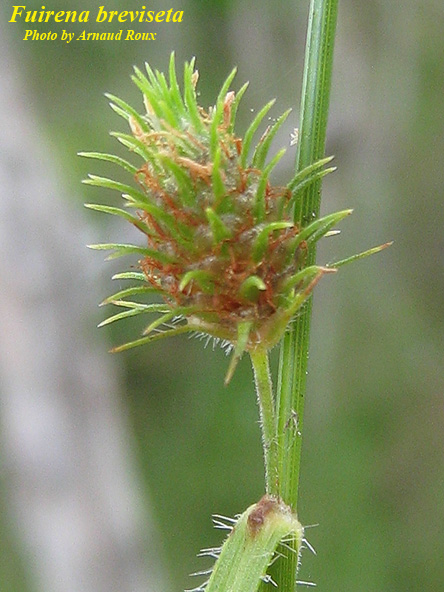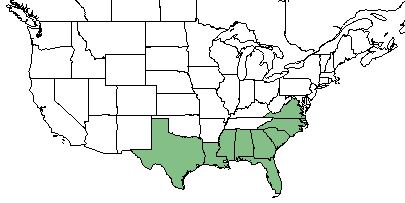Difference between revisions of "Fuirena breviseta"
(→Habitat) |
(→Description) |
||
| Line 22: | Line 22: | ||
| − | ==Description== | + | ==Description== <!-- Basic life history facts such as annual/perrenial, monoecious/dioecious, root morphology, seed type, etc. --> |
| − | ''F. breviseta'' is a perennial graminoid of the Cyperaceae family that is native to North America. <ref name= "USDA"> [https://plants.usda.gov/core/profile?symbol=CEAM USDA Plant Database]</ref> | + | ''F. breviseta'' is a perennial graminoid of the Cyperaceae family that is native to North America.<ref name= "USDA"> [https://plants.usda.gov/core/profile?symbol=CEAM USDA Plant Database]</ref> It can reach heights up to 3 feet tall with bloom color ranging from yellow to green and to brown.<ref>[[https://www.wildflower.org/plants/search.php?search_field=&newsearch=true]] Lady Bird Johnson Wildflower Center. Accessed: May 13, 2019</ref> |
| − | < | ||
==Distribution== | ==Distribution== | ||
Revision as of 15:41, 13 May 2019
Common Names: saltmarsh umbrella-sedge [1]; short-bristled umbrella-sedge
| Fuirena breviseta | |
|---|---|

| |
| Photo by the Atlas of Florida Plants Database | |
| Scientific classification | |
| Kingdom: | Plantae |
| Division: | Magnoliophyta - Flowering plants |
| Class: | Liliopsida - Moncots |
| Order: | Poales |
| Family: | Cyperaceae |
| Genus: | Fuirena |
| Species: | F. breviseta |
| Binomial name | |
| Fuirena breviseta Coville | |

| |
| Natural range of Fuirena breviseta from USDA NRCS Plants Database. | |
Contents
Taxonomic Notes
Synonyms: F. squarrosa Michaux
Description
F. breviseta is a perennial graminoid of the Cyperaceae family that is native to North America.[1] It can reach heights up to 3 feet tall with bloom color ranging from yellow to green and to brown.[2]
Distribution
F. breviseta is found in Florida, Georgia, South Carolina, North Carolina, Alabama, Mississippi, Louisiana, and Texas. [1] This plant is a southeastern coastal plain endemic species.[3]
Ecology
Habitat
Common habitats for F. breviseta is Carolina bays, savannas, ditches, and other wetlands. [3] Habitats of specimens collected include drying loamy sands of a ditch, wet sand on edge of a dike, pond pargin in shallow water, on edge of pine plantation, on border of wakulla river, wet pine flatwoods, and on edge of a lake. [4] This species is listed by the USDA Natural Resources Conservation Service as an obligate wetland species that is only found in wetland habitats.[1]
Phenology
Generally, F. breviseta flowers from July until October.[3] It has been observed flowering in September, October, and November. [5]
Conservation and Management
Cultivation and restoration
Photo Gallery
References and notes
- ↑ 1.0 1.1 1.2 1.3 USDA Plant Database
- ↑ [[1]] Lady Bird Johnson Wildflower Center. Accessed: May 13, 2019
- ↑ 3.0 3.1 3.2 Weakley, A. S. (2015). Flora of the Southern and Mid-Atlantic States. Chapel Hill, NC, University of North Carolina Herbarium.
- ↑ URL: http://herbarium.bio.fsu.edu. Last accessed: June 2018. Collectors: Loran Anderson, Travis MacClendon, Karen MacClendon, R.K.Godfrey, R.F. Doren, Cecil Slaughter, William Platt, Garret Crow, Walker Judd. States and counties: Florida (Jefferson, Wakulla, Liberty, Calhoun, Jackson, Dixie, Washington, Marion, Duval, Osceola, Gadsden, Nassau, Alachua, Gulf), Georgia (Thomas)
- ↑ Nelson, G. PanFlora: Plant data for the eastern United States with emphasis on the Southeastern Coastal Plains, Florida, and the Florida Panhandle. www.gilnelson.com/PanFlora/ Accessed: 21 MAY 2018